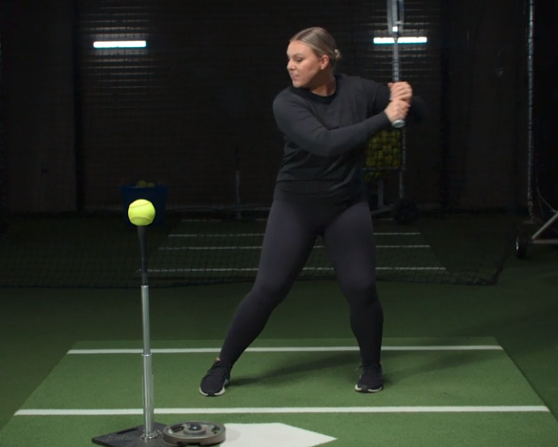Hitting Fundamentals: Upper & Lower Body

How to use the whole body to generate real power and precision at bat.
How to use the whole body to generate real power and precision at bat.
If you missed the first lesson from the hitting fundamentals series, do yourself a favor and go back to check it out here.
In this course, Amanda Lorenz—one of the greatest hitters of all time—is generously sharing the secrets she used to dominate as a hitter in college and now in professional softball.
We’re going to keep this intro short because there’s a lot of material to cover.
This article incorporates the main points from two exclusive video sessions Lorenz produced by Versus. You can access both videos, plus the full library of content by signing up for one of our Game Plans.
We’ve got packages to suit everyone’s needs, including a free option to see if Versus is for you.
Our paid plans include unlimited video sessions from our roster of elite athletes and world-class coaches, plus future course content participation and interactive content.
However, in this session, Amanda takes us through everything hitters need to know to generate real power and precise hits at bat.
Let's start with her instructions on energy and weight distribution in the lower body.
Creating True Energy
Most of a hitter's power comes from the lower body—so it’s crucial to know how to generate and direct energy from there.
When she’s hitting, Amanda imagines all of her energy being stored in a triangle between her feet and legs. “All of the energy I’m going to store and give stays inside this triangle,” she says.

Key points in this triangle are the insides of the knees and feet. As the hitter shifts their weight back and forth, energy is stored and transferred between these points.
In a neutral position, the potential energy is equally distributed (50/50) between the knees and feet.

Once the hitter initiates load, it shifts to the back knee and foot (75/25).

As the swing commences, energy starts to transfer from the back knee to the front (60/40), like this.

Lorenz describes energy from within the triangle as “real” and anything outside “fake.” An example of “fake energy” would be storing energy outside the hip.
That energy will never make it into the triangle. It ends up going in the opposite direction of the swing, resulting in a loss of power.
Now that we’ve covered the lower half of the body, it’s time to see how to use the hands.
Hands Follow the Body
“Our hands and lower half are on the same team,” explains Amanda.
As she’s loading her lower half, Lorenz imagines she’s stretching a rubber band with her hands and upper body, “so it can explode toward the ball.”
Using a loose grip with her knuckles lined up.

Lorenz moves her hands back as she loads the lower body, ensuring a good amount of stretch for a powerful swing.

Players with an overly tight grip or who are tense in the body can forget to breathe and stretch. This results in trying to attack the ball from a compromised, less powerful position.
Remember, hands and body move together. So right after you initiate the load, stretch that rubber band with your hands to load up for a big swing.
Barrel Stays in the Zone
In a prior lesson in this series, Lorenz stressed the importance of adjusting to whatever pitch comes your way. Keeping your barrel in the hitting zone is central to this strategy.
“I want to show the pitcher my barrel for as long as possible”, explains Amanda. “That way, if she throws a little bit slower or faster, I’m able to adjust and still impact the ball the way I want to.”
Focusing on contact point and extension are Amanda’s top tips for getting this part of the swing right.
Contact point is dictated by the type of pitch you’re hitting. No secrets or shortcuts here. The only way to dial in your contact point for all types of pitches is through practice and repetition.
When it comes to extension—try to keep the barrel aimed where you want the ball to go for as long as possible. Keep moving through the zone until elbows are fully locked, only then finish your swing.
Here’s what it looks like for an inside pitch.

Now that we’ve been through the entire swing, let's do a quick recap and look at adjustments for high and low balls.
Load, Contact Point, Extension
Lorenz recommends a stepped approach to locking in the three components of your swing. When one is dialed in, move on to the next. Finally, practice stringing all these three steps together in sequence.
- Load - Practice transferring energy between your back and front legs, using the triangle between the insides of your knees and feet. Avoid using “fake power” from outside the triangle. Make sure to get a good stretch with your hands—remembering the upper and lower body work together.
- Contact Point - Know your specific contact point each swing, to direct the ball where you want it. The goal is perfect ball flight during practice, as that’s what you want in the game.
- Extension - Keep your barrel in the hitting zone for as long as possible. A helpful cue is “show the barrel to the pitcher.” Point the barrel where you want the ball to go until you reach full extension with elbows locked, only then finish your swing.
Here are some adjustments for pitches that come in high or low.
Rise Ball
Being a taller player, Lorenz loves hitting rise balls. Here’s how she uses lower body positioning right before making contact.

Power is distributed at 60/40. The back knee is only slightly bent. Hands move in line with the lower half of the body.
In terms of contact point, Amanda focuses on staying above the ball as much as possible, with the barrel almost level. She’s trying to hit a hard line drive to send a rise ball right back where it came from.
Low Ball
Drop balls are not Amanda’s favorite. To get underneath a low ball, she drops her back knee close to the ground, using the cue—“get my knee dirty.”
This is the position she’s aiming for.

From here, Amanda’s whole center of gravity shifts downwards and she has to actively engage her core. Remembering that hands follow the lower half, we see how the lower body dictates the height of your swing.
For contact point, barrel position is quite different to a rise ball—it looks like this.

Lorenz’s goal is to get underneath a low ball and impact the bottom of the ball. This requires making sure her hands follow the position she’s set with her lower half.
A System for Success
In softball and baseball—the best hitters are those who can adapt and adjust.
A hitter that dictates the play in challenging conditions always outperforms one who has to wait for the perfect pitch to make something happen.
In her sessions on timing and utilizing the upper and lower body, Amanda Lorenz outlines a comprehensive system of success for any hitter.
The fundamental skills she covers provide instruction on hitting all types of pitches under any circumstances. Lorenz also explains how athletes can adapt her approach according to their own needs and conditions in the game.
If you want to go deeper on hitting mechanics and what it takes to have a hitter’s mindset, head over to Versus and check out our Game Plans. Any of our packages will get you access to her lessons, plus tons of other training sessions, interactive content, and more.
Keep up with the Versus community.
Get notified of new content releases, new features, and much more!
Sign up to get new article notifications
Join our newsletter for new course release updates and get early access to upcoming course trailers.










